on all orders over $100
on all orders over $100
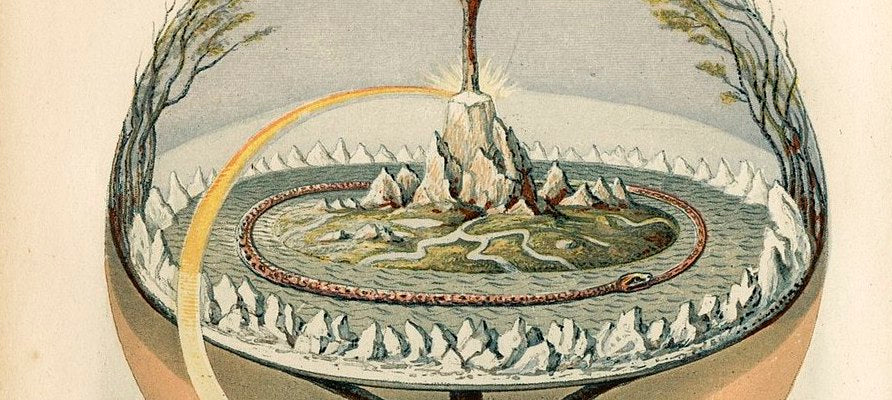

Midgard translates from Old Norse to "middle enclosure". It was created by Odin and his two brothers from the body of the giant Ymir, and was the made to be the realm of men. The story says that the three brothers made the first man and woman, Ash and Elmba, from the ashes of an elm tree. These two then went on to populate the world and give birth to the rest of mankind. This was said to be the only one of the nine realms which was fully located in the visible world.
In norse sagas the god of thunder, Thor, was said to be the protector of Midgard. His arch-nemesis, the giant serpent Jormungandr, was sometimes called the 'Midgard Serpent' or the 'World Serpent', due to his role in encircling the oceans of the world. It was said that he would rise up from the oceans and cause huge waves to wash ashore bringing great destruction and wreaking havoc upon humanity.
The earth was also referred to as Midgard in one famous Old English poem known as Beowulf.
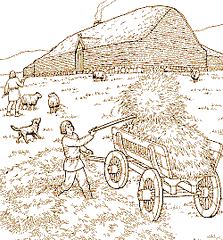
Life in the Viking age - Anonymous
In Norse mythology Gods including; Odin, Thor, Loki, Frigg and Heimdall, amongst others were all part of the most prominent tribe of Norse Gods known as the Aesir. Asgard was the home of the Aesir and was vaguely described in the sagas as being located somewhere in the sky. It was connected to the aforementioned Midgard (the world of men) by a rainbow bridge known as the Bifrost. This bridge was operated by Heimdall, and allowed for inter-world travel by the Gods.
Asgard was described in the Prose Edda as a great city with many towers and high walls. It was from his throne, Hildskjalf, in this great city that Odin could see all of the 9 realms.
The realm of Asgard was also the home of Valhalla, a great hall where worthy Viking warriors who died in battle would go and wait to be called to fight at Ragnarok. These slain warriors were known as Einherjar.
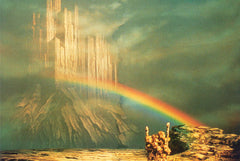
Bifrost between Asgard and Midgard - Richard Wagner’s Das Rheingold, directed by Otto Schenk, 1990
Vanaheim was home to the tribe of Norse Gods known as the Vanir. According to the Norse Sagas they had been at war with the Aesir in the past and exchanged hostages in order to keep the peace intact. Amongst these hostages were Vanir gods such as Frey and Freya, who lived in Asgard as part of the peace agreement. In both the Prose Edda and the Poetic Edda, Vanaheim was said to be the realm of the prominent Vanir god, Njord.
Vanaheim was thought to be a fertile and magical land, however there are no surviving descriptions of this realm that are of sufficient detail to support this thesis. Most of the Vanir gods were associated with fertility, sorcery and fortune telling. It is thought that they went to war with the Aesir over cultural differences about issues such as incest and the use of forbidden magic.
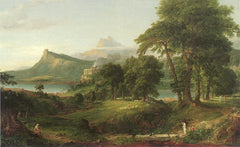
The Course of Empire: the Pastoral or Arcadian State - Thomas Cole, 1834
This world was inhabited by the 'Jotun' who were a race of frost giants. They appeared often in Norse Sagas, often playing the role of the antagonists, causing various problems for the Aesir.
Jotunheim was a realm of pure chaos and disorder, in stark contrast to the worlds of the Gods such as Asgard and Vanaheim. Loki was said to be one of the Jotun and it was supposed that he too could have been a hostage that was exchanged in order to keep the peace between Jotunheim and Asgard, in a similar way to the hostages exchanged after the Aesir-Vanir war.
This chaotic realm was located beneath Asgard and was separated from it by the river Ifingr, which was notoriously difficult to cross and never froze, no matter the temperature. Aesir gods were often described as crossing the river to enter Jotunheim in order to search for giantess lovers, and according to the Prose Edda even Thor himself was said to have travelled there on a quest.
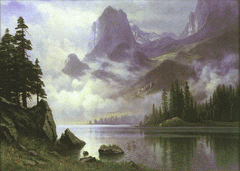
Mountain out of the Mist - Albert Bierstadt, 1873
Along with Muspelheim this was one of the oldest of the 9 realms, although the climates of the two realms could not be more different. Niflheim was said to be a primordial land of ice and mist, where all life in the universe began. In the Norse Creation story the great giant Ymir, who was the first living being, was created when the fire from Muspelheim met with the Ice from Niflheim.
Descriptions of Nilfheim depict a world that is inhospitable and largely uninhabited, even by the hardy frost giants. This was said to be the location of Hvergelmir, which was one of the wells which nourished the life tree, Yggdrasil, which lead many historians to speculate that Niflheim was situated below the roots of the world tree.

Morning Mist in the Mountains - Caspar David Friedrich, 1808
A realm of chaos and fire, Muspelheim, along with Niflheim, was one of the oldest worlds in Norse cosmology. They both played a key role in both the creation and destruction of the Norse universe.
Muspelheim was a primordial world full of fire and lava and was the home of the great fire giant, Surtr. He was destined to be freed from his realm by a great earthquake during Ragnarok and lead the armies of chaos in their great battle against the Norse Gods. The prophecy said that he would unleash havoc on Asgard, destroying the city with his great burning sword.
This sequence of events was often thought to be one of the many Norse Mytholigical inspirations for the Lord of the Rings trilogy and the creature on which the 'balrog' was loosely based.

Vesuvius from Portici - Joseph Wright of Derby, 1775
The world of Elves, also located in the heavens, was said to be close to Asgard. It was home to a race called the bright elves, who were known for their music, poetry, art and magic. The realm itself is not described clearly in Norse writings however due to its position close to Asgard and the nature of its inhabitants it lead historians to believe that it was an organised and elegant land.
One puzzling fact about Alfheim that was mentioned in the Norse sagas was that the God Frey, of the Vanir tribe, was said to be the its ruler. The reason for his position there is not known, however modern historians theorise that it have been the case that Frey himself was of elvish descent, in a similar way that Loki was Jotun.
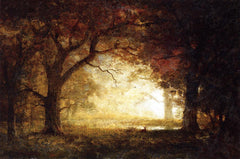
Forest Sunrise - Albert Bierstadt, 1873
Known as both Nidavellir and Svartalfheim this was the world of Drawves, who were known for their craftsmanship and magic. It was here that Mjolnir, the Hammer of Thor was created, along with other famous artefacts of Norse Mythology such as; Gungnir, Draupnir, Gullinbursti and Skidbladnir.
This world was said to be located deep beneath surface of the earth where their tunnels were lit only by the fires of their forges and torches on the walls. The name 'Nidavellir' was mentioned in earlier Norse texts where it was said to be the home of Sindri, a Dwarf that was mentioned in other sagas, most notably it was his sons who crafted Mjolnir.
The name 'Svartalfheim' only appears later in the Prose Edda, which was written centuries after the end of the Viking age, and is therefore considered to be a generally less reliable source. Confusingly this name translates to 'world of dark elves' which may indicate that there was some overlap between the dwarves and these other mythical creatures, however it could also be a complete fabrication that was not part of the original mythos of the Norse universe during the Viking age.

Soria Moria Castle - Theodor Kittelsen, 1990
Helheim was a gloomy and dark underworld which was presided over by the goddess Hel, daughter of Loki and sister to Jormungandr and Fenrir. Hel was cast into the dark realm by Loki as he knew that she was likely to cause trouble.
Helheim itself was said to be located below YggdrasilThe realm could only be reached by travelling down a long path, known as Helveg. The world was inhabited by the souls of the dead who did not die in battle and of those who died of old age o disease. Hel herself was said to be a giantess who was said to be rather melancholy, quite a contrast to the character in the Marvel film.

Heimdall Desires the Return of Idun from the Underworld - Emil Doepler, 1881
If you enjoyed our article or if there's anything you'd like to add please leave a comment below.
Check out some of our handmade Viking Axes.
Leave a comment